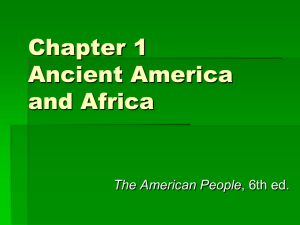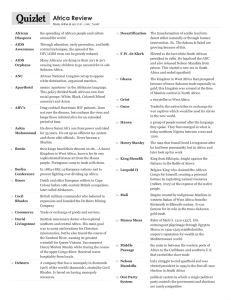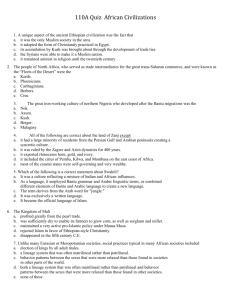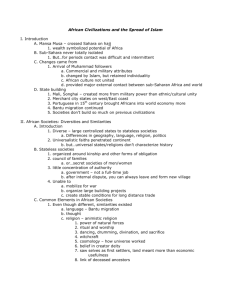1285783123_432029
advertisement
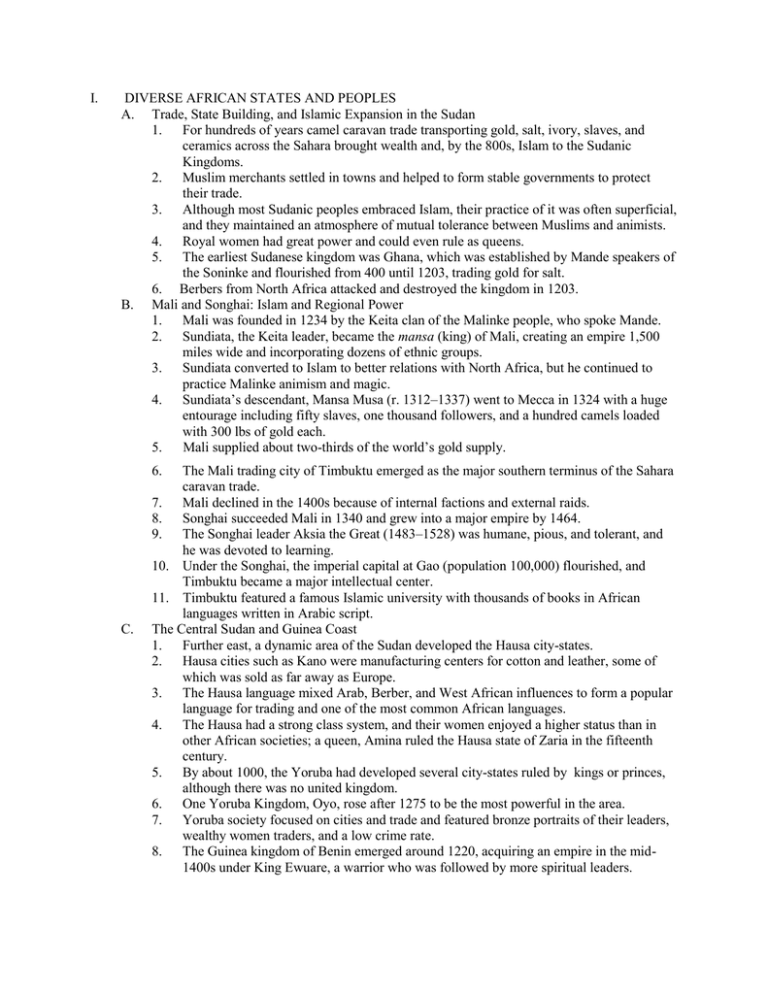
I. DIVERSE AFRICAN STATES AND PEOPLES A. Trade, State Building, and Islamic Expansion in the Sudan 1. For hundreds of years camel caravan trade transporting gold, salt, ivory, slaves, and ceramics across the Sahara brought wealth and, by the 800s, Islam to the Sudanic Kingdoms. 2. Muslim merchants settled in towns and helped to form stable governments to protect their trade. 3. Although most Sudanic peoples embraced Islam, their practice of it was often superficial, and they maintained an atmosphere of mutual tolerance between Muslims and animists. 4. Royal women had great power and could even rule as queens. 5. The earliest Sudanese kingdom was Ghana, which was established by Mande speakers of the Soninke and flourished from 400 until 1203, trading gold for salt. 6. Berbers from North Africa attacked and destroyed the kingdom in 1203. B. Mali and Songhai: Islam and Regional Power 1. Mali was founded in 1234 by the Keita clan of the Malinke people, who spoke Mande. 2. Sundiata, the Keita leader, became the mansa (king) of Mali, creating an empire 1,500 miles wide and incorporating dozens of ethnic groups. 3. Sundiata converted to Islam to better relations with North Africa, but he continued to practice Malinke animism and magic. 4. Sundiata’s descendant, Mansa Musa (r. 1312–1337) went to Mecca in 1324 with a huge entourage including fifty slaves, one thousand followers, and a hundred camels loaded with 300 lbs of gold each. 5. Mali supplied about two-thirds of the world’s gold supply. 6. C. The Mali trading city of Timbuktu emerged as the major southern terminus of the Sahara caravan trade. 7. Mali declined in the 1400s because of internal factions and external raids. 8. Songhai succeeded Mali in 1340 and grew into a major empire by 1464. 9. The Songhai leader Aksia the Great (1483–1528) was humane, pious, and tolerant, and he was devoted to learning. 10. Under the Songhai, the imperial capital at Gao (population 100,000) flourished, and Timbuktu became a major intellectual center. 11. Timbuktu featured a famous Islamic university with thousands of books in African languages written in Arabic script. The Central Sudan and Guinea Coast 1. Further east, a dynamic area of the Sudan developed the Hausa city-states. 2. Hausa cities such as Kano were manufacturing centers for cotton and leather, some of which was sold as far away as Europe. 3. The Hausa language mixed Arab, Berber, and West African influences to form a popular language for trading and one of the most common African languages. 4. The Hausa had a strong class system, and their women enjoyed a higher status than in other African societies; a queen, Amina ruled the Hausa state of Zaria in the fifteenth century. 5. By about 1000, the Yoruba had developed several city-states ruled by kings or princes, although there was no united kingdom. 6. One Yoruba Kingdom, Oyo, rose after 1275 to be the most powerful in the area. 7. Yoruba society focused on cities and trade and featured bronze portraits of their leaders, wealthy women traders, and a low crime rate. 8. The Guinea kingdom of Benin emerged around 1220, acquiring an empire in the mid1400s under King Ewuare, a warrior who was followed by more spiritual leaders. 9. II. Benin City was surrounded by high walls twenty-five miles in circumference, protecting an elaborate royal palace and neat houses. 10. Benin had an innovative welfare system to protect the poor from starvation. 11. Benin began to decline in 1550 but lasted until 1897. D. The Bantu Diaspora 1. Historians debate whether Bantu expansion involved large-scale migration or small numbers of Bantu speakers moving to new areas and mixing with local people who adopted their language. 2. In East Africa, Bantus came into contact with Nilotes, with whom they sometimes intermarried, traded, or fought, such as the Bantu Gikuyu and the cattle-herding Nilotic Masai. 3. In East Africa bananas were the staple crop. E. East African Commerce and Swahili Culture 1. Islam and global commerce integrated East African coastal populations and linking East Africa with Indian Ocean societies. 2. Indonesians visited East Africa bringing bananas, coconuts, and yams, and some settled on Madagascar. 3. Arabs came to dominate the coastal trade among coastal city-states such as Mogadishu, Lamu, Malindi, Mombasa, Zanzibar, Kilwa, and Sofala. 4. The golden age of the East African coast began in the ninth century and reached its peak in the twelfth to fifteenth centuries. 5. When the Moroccan jurist Ibn Battuta visited Kilwa he noted its three-story stone houses with indoor plumbing, large quantities of gold, Chinese silk and porcelain, and food influenced by South Asia. 6. Bantu, Arab and Islamic influences melted together to produce a new African culture and language, Swahili (“people of the coast”). 7. The Swahili were, like Arabs, firmly patrilineal. F. Zimbabwe and the Kongo 1. The Shona people constructed buildings of impressive stone, giving the name of the region “Zimbabwe,” (“houses of stone”). 2. The capital had several large stone enclosures, including the Great Zimbabwe complex with walls 1,800 feet long, 32 feet high, and 17 feet thick. 3. Mining gold, copper, and iron was the key to Zimbabwe’s prosperity. 4. The kingdom of the Kongo was established by the Bakongo people, population 2.5 million, at a commercial hub near the Atlantic Ocean. 5. The Kongo elite lived well in the capital of Mbanga, wearing finely-woven and dyed cloth fabrics. 6. The king in theory was divine, but he was elected by elders, faced restrictions, and had to seek advice from a council of leaders from leading clans. 7. Common people lived in houses of palm matting and thatch roof, eating millet porridge and participating in a seashell-currency economy. AFRICAN SOCIETIES, THOUGHT, AND ECONOMIES A. Political and Social Patterns 1. The stateless society of the Tiv in eastern Nigeria was egalitarian and allowed no exploitation; elders provided land to each according to need, women controlled the fields, and politics were democratic, relying on group discussion and public opinion. 2. Various societies practiced matrilineal kinship, and the queen sister or queen mother was highly respected, controlling treasuries and presiding over courts; some queens ruled in their own right, though women’s status varied widely. 3. The chief goal of marriage was having many children, the source of support in old age. The ethnic group, often mistakenly called “tribe,” included people with a common culture and language, who lived in the same general territory. 5. Some sub-Saharan groups engaged in slavery or the slave trade. B. Religious and Artistic Traditions 1. While African religions were diverse, Africans often recognized a supernatural world mediated by spiritual specialists and healers, or shamans, who were skilled in curing disease and had knowledge about the spiritual realm. 2. African spirituality often included belief in a life force that was part of all living and material entities. 3. Professional rememberers, griots, served as local historians, record-keepers, and walking libraries; for example, oral traditions chronicle the histories of 67 kings in a Sudanic kingdom called Kanem-Borno from the ninth through the nineteenth centuries. 4. Writing spread slowly because Africans had communal ownership, so they did not need written laws, and because paper deteriorated quickly in the tropical African climate. 5. Paleolithic Africans were among the first people anywhere to do paintings on rocks and cave walls. 6. When farming developed, Africans turned to sculpture and wooden masks or carvings as their major visual art form. 7. Among the greatest African cultural traditions were dance and music, particularly percussion and drums; when mixed with wind and string instruments these African roots fostered popular twentieth-century music styles such as blues, jazz, rock, and salsa. C. Agriculture and Trade 1. Tropical diseases and insects killed large draft animals, so Africans were forced to rely on human muscle for production and transportation, and most relied upon farming to produce food primarily for their own use. 2. Faced with poor soils, irregular rainfall, and no manure, shifting cultivation was an effective agricultural adaptation as long as population densities remained small. 3. Trading networks interlaced tropical Africa with great markets at Sudanic cities such as Goa and Timbuktu. 4. Women predominantly ran markets while traveling merchants were usually men. D. Africans, Arab Slave Traders, and the Portuguese 1. Between 650 and 1500 the trans-Saharan caravans transported 2–4.7 million slaves from West Africa to the Mediterranean; up to 2 million were shipped from East Africa and 1.6 million from Red Sea ports. 2. Approximately 250,000 descendants of African slaves, traders, and sailors live in India and Pakistan today. 3. Well-armed Portuguese ships sailed down the African coast to procure Asian spices, African gold, and slaves directly in West Africa. 4. The Portuguese colonized the Cape Verde Islands and Guinea-Bissau, as well as establishing several forts along the coast. 5. Bartolomeu Dias rounded the Cape of Good Hope at the southern tip of Africa, sailing into the Indian Ocean in 1487. 6. Vasco da Gama reached southern India after sailing along the East African coast in 1497. 7. In the 1480s the Portuguese began a long relationship with the Kongo kingdom, whose king, Nzinga a Nkuwu, converted to Christianity in 1491; in 1514, his successor began exporting slaves to nearby islands and, eventually, the Americas. III. AMERICAN SOCIETIES IN TRANSITION A. The Collapse of the Classical States 1. Americans creatively adapted to their environments, dominating large regions with their productive farming and irrigation, creating a well-balanced, healthy diet. 2. Great cities such as Teotihuacan, Tikal, and Tiwanaku flourished for centuries. 4. 3. B. C. D. Between 700 and 1000, many centers of power collapsed, possibly because of climate change that brought about drought. The Zenith and Decline of the Maya 1. The Maya enjoyed a peak between 600 and 800 when their population density was a staggering 600 people per square mile. 2. Mayans were excellent sculptors, builders, astronomers, and mathematicians. 3. Reasons for Mayan collapse could include climate change leading to a long drought, overpopulation, soil degradation, deforestation, military defeats, and governmental instability. 4. The collapse occurred first in the southern Yucatan; northern cities continued to thrive, such as Xumal until around 1000, Chichen Itza from 800 to 1250, and the state of Mayapan from 1250 to 1441. 5. By the 1500s, the Yucatan Maya fragmented into small states in chronic conflict with each other. 6. The remaining Maya people were reduced to subsistence farming. The Toltecs and Chimu 1. King Mixcoatl (“Cloud Serpent”) led the Toltecs into the central valley of Mexico from the desert north, creating an empire that lasted from 900 to 1168. 2. The roots of the Toltecs lay in the city of Teotihuacan near today’s Mexico City. 3. The Toltecs adopted the cult of the feathered serpent Quetzalcoatl, a bearded, fairskinned human leader banned to sea by the war-gods and fated to return to seek revenge, a figure who may have been based on the human priest Topiltzin (b. ca. 947). 4. The capital, Tula, had ceremonial architecture and was a center for obsidian mining. 5. In the twelfth century, the Toltec state, weakened by drought, famine, and war, collapsed. 6. The huge Chimu Empire emerged with its center at adobe-walled Chan Chan, a location focused upon copper manufacturing. 7. Chimu lords had elaborate funerals in which several hundred men and women were sacrificed to serve as attendants in the afterlife. 8. The Chimu were great builders, creating 25-foot-wide main roads and excelling at irrigation, including terraces, large storage reservoirs, and linking five separate river valleys into a single complex. 9. El Niño climate changes, overpopulation, and soil salinization caused the Chimu to decline by the fourteenth century. Pueblo Societies 1. Pueblo Indians in the North American Southwest survived through trade and by becoming experts at selecting the right soils to cultivate with irrigation to grow maize. 2. The Hohokum and Mogollon societies dominated the Southwest from 700 to the 1300s, when climate change caused them to abandon their settlements. 3. The Hohokum built large buildings such as the three-story-high Casa Grande. 4. The Mogollon developed masonry technology for house building. 5. The Anasazi (“ancient ones” in Navaho) flourished between 700 and 1400, building ingenious housing into steep cliff walls in major centers at Mesa Verde and Chaco Canyon. 6. Anasazi lived in egalitarian communities practicing matrilineal kinship and matrilocal residence, with women owning houses, crops, and fields, while men dominated the council of elders. 7. Environmental challenges eventually precipitate collapse, with disease, invasions, and increased warfare also possible factors. 8. By 1400 Anasazi culture had collapsed, and those Anasazi who survived were probably the ancestors of southwestern tribes like the Hopi and Zuni. E. The Mississippian and Eastern Woodland Societies 1. The Mississippian culture flourished between 700 and 1700, displaying cities, monumental architecture, social hierarchy, ethnic diversity, religious art, and longdistance trading activity. 2. The main Mississippian culture center was Cahokia at the junction of the Missouri and Mississippi rivers, near modern St. Louis; it probably had a population of 30,000-60,000 at its peak. 3. Mesoamerican influences are indicated by large pyramid complexes. 4. When a ruler died, priests sacrificed some commoners to accompany him into the hereafter. 5. Cahokia society was matrilineal and divided into classes. . 6. Cahokia was largely abandoned around 1300, probably because of environmental crises. 7. Eastern woodland communities resembled African stateless societies, practicing consensus politics and electing chiefs without much authority. 6. Men cleared the fields but spent most of their time hunting or fighting. Women produced most of the food and had power to approve of warfare. IV. THE AMERICAN EMPIRES AND THEIR CHALLENGES A. The Aztec Empire, Religion, and Warfare 1. The Mexica, militaristic immigrants from the north, founded the Aztec empire. 2. The Nahuatal-speaking Mexica founded the capital of Tenochtitlan in the same Valley of Mexico where Teotihuacan had once flourished. 3. Moctezuma I (1440–1468) was the greatest Aztec ruler, using war to gain new territories. 4. The Aztec religion supported their war-making; their sun god, a warrior, needed the blood of sacrificial victims in order to fight his way across the sky every day, and another god, Huitzilopochtli (“The Hummingbird Wizard”) demanded to be fed with fresh human hearts. 5. The cruelty of the Aztecs created an unstable imperial system with frequent rebellions; the many enemies of the Aztecs were eager to help the Spanish when they landed in 1518. B. Aztec Economy and Society 1. The Aztec capital of Tenochtitlan, one of the world’s great cities with between 150,000 and 300,000 residents, was built on a swampy island, served by diverse markets and thousands of canoes along six major canals traversing the city. 2. The Aztecs grew food on chinampas (artificial islands) and by means of elaborate irrigation works. 3. Aztec merchants established a regional trade system, acted as spies, and traveled in armed convoys. 4. The hierarchical Aztec society ranged from an emperor, high officials, priests, warriors, and artists, to tenant farmers and slaves. 5. Aztec society was patriarchal; elite women were secluded and largely limited to childbearing and weaving, but common women had more freedom to pursue careers, such as in commerce or midwifery. C. The Inca Imperial System 1. The Incas conquered an empire in the Andes much larger than the Aztec empire. 2. The Inca leader Viracocha, claiming to be a living god, launched a campaign of conquest that was carried even further by his son Pachacuti (r. 1438–1471), who conquered the Lake Titicaca basin and the Chimu empire. 3. The Incas ruled both the Peruvian highlands and the coastal zone, an empire stretching nearly 3,000 miles, united for the first time under one government ruling from Cuzco, a capital with a population of 60,000 to 100,000. 4. D. E. Children from noble families of conquered peoples might be sacrificed on a mountain top as a gift to the mountain gods. Their bodies were mummified by the cold temperatures. 5. The Inca social system was hierarchical and rigid, with divine, interbred royalty. 6. Rivalries for the throne could lead to civil war, such as the exhausting one fought right before the Spanish arrived in 1532. Inca Political Economy, Society, and Technology 1. Unlike the Aztecs, where merchants ran the economy, the Inca state ran the economy in their society. 2. Inca society was patriarchal, although both men and women made pottery, worked in the fields, and worshiped gods with both male and female characteristics; there were several female deities, including an Earth Mother. 3. The mountaintop settlement of Machu Picchu was an elite retreat site. 4. The Incas built 14,000 miles of road with relay runners who could move a message 150 miles a day. 5. Incas developed technical innovations such as a sophisticated recordkeeping system using quipus (colored knotted strings), extensive agricultural engineering projects, and sophisticated medical techniques including surgery with anesthesia. American Societies and Their Connections 1. Matrilineal patterns were common in North America, while patriarchal societies were common in Mesoamerica and South America. 2. Armies fought hand to hand with the goal of capturing rather than killing opponents. 3. The American population, probably around 60 to 75 million, was healthy but lacked resistance to diseases carried from the Eastern hemisphere after Columbian contact. 4. Greenland-based Vikings led by Leif Ericson made a settlement in Newfoundland and Labrador around 1000, but they abandoned these and did not publicize their discoveries in Europe. 5. In 1492 the Italian Christopher Columbus, in search of Asia, reached the Bahamas, opening a new world to European conquest and disease.
